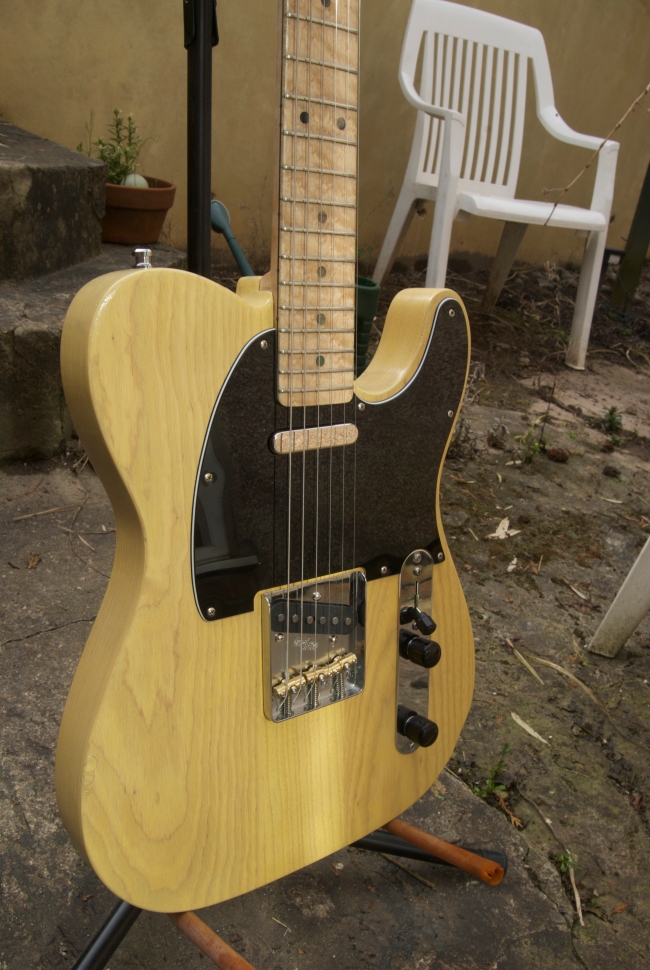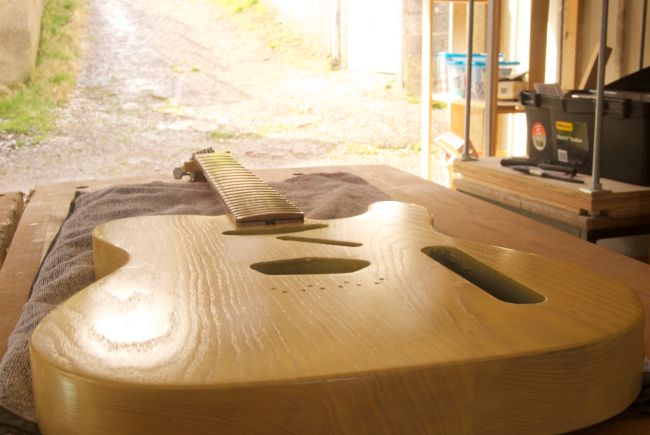After almost exactly 2 years (including a lengthy, wedding related, hiatus) the Telecaster build is now done. I need to do a final set up including tweaking the playing action and truss rod, but that can wait for another day.
Yesterday, having waited for the cure time on the body lacquer to finish, I assembled the guitar.
Some of the hardware already had holes drilled from the trial stringing back in November, so for the neck and bridge installation was simply a case of screwing everything in. For the pick guard, control plate, and strap buttons however I first marked out the position of the screws using my Blue Spruce brad awl, and then drilled pilot holes using a Dremel. I appreciate that using anything battery powered is a departure from my hand tool only approach, but for some tasks a Dremel just can’t be beat, and the numerous small (2.5mm diameter) pilot holes I needed for the hardware was one of these tasks. Once the pilot holes were drilled, I then used a 10mm diameter counter sink bit in my egg beater hand drill to gently counterbore the tops of the pilot holes, so that the screw threads would not lift wood fibres.
Fitting the hardware to the body was a bit of a jigsaw. The position of the bridge was fixed by virtue of the scale length of the strings, and also the route for the bridge pickup. The control plate and pickguard however still had some room for movement, and it was important that they lined up with each other. My approach was to fix the pickguard first by reference to the neck and the bridge, and then slide the control plate in next to it.
The string ferrules on the back of the guitar were press fit, with the holes drilled just large enough to accept them prior to applying the lacquer. With the body lacquered, the holes were slightly too small for the ferrules to fit. This was intentional, as it ensured that there was no bare wood or gap around the edge of the ferrules. To fit them, each ferrule was placed over the appropriate hole, and then heated with the tip of a soldering iron just enough to allow the lacquer to melt and the ferrule to slide into the hole, before being wiped down with a damp rag to stop the wood scorching.
The final job was to solder and fit the electronics. It’s been a long time since I’ve wielded a soldering iron in anger, and despite being a relatively simple circuit, this was the longest part of the job. The electronics were soldered outside of the body, as there is very little room in the control cavity, before being hooked up to the pickups and the control plate screwed in place. For this guitar I opted for a 4 position selector switch (instead of the usual 3 position switch found on genuine Telecasters) with the 4th position placing both pickups in series, for a quasi-humbucking tone.
After all that, I got to play her. And despite needing that final set up, she sounds great. The Bare Knuckle Pickups really twang (this is a mid-50’s spec blackguard, after all) and the chunky boat neck profile feels surprisingly comfortable. I’m looking forward to getting to know this guitar better.
A full photo shoot will follow in the next entry.



